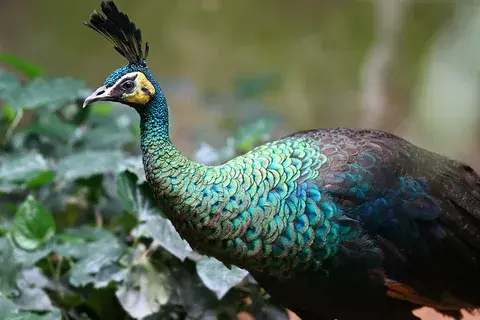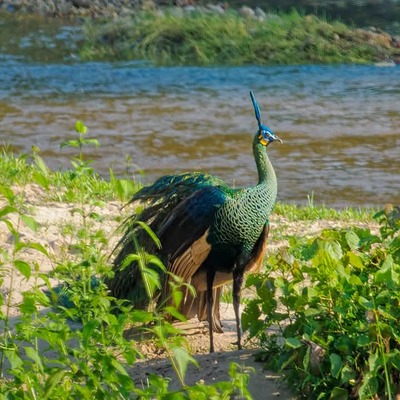Blog
Peacock Colours: What They Are & Why They Matter

Whether you have ever asked yourself the question, What are the peacock colours and why do some of them look so different, you are in the right place. The colours of the peacock plumage are not accidental, but are produced by nature, the structure of the feathers, and some rare mutations. Iridescent blue and iridescent black-shouldered are the most common, but there are also rare versions, including white, pied, green java, cameo, and silver pied.
This knowledge of the colours would enable breeders, collectors, and enthusiasts to select the most desirable birds. We shall see in this guide all the known types of colour, their source, and where they may be found–particularly in a bird shop in Pakistan.
The Mechanism of Occurrence of Peacock Colours: Structure, Pigment, and Mutation
The Science of the Colour of Peacocks
The shining blues and greens of Indian Peafowl are a result of microscopic structures of feathers that refract and reflect light. This is referred to as structural coloration. A study published in the Royal Society Journal describes the formation of the iridescent shimmer by the nanostructures in the barbules that make peacocks special (Royal Society – Structural Colours in Birds).
Darker colors are added with the help of pigments such as melanin, whereas white or pied patterns are provided by genetic mutations (such as leucism).

Mutations & Changes in Pattern
The United Peafowl Association estimates that dozens of combinations of colour and pattern are in existence, including:
- Indian Blue (standard glossy blue and green feathers)
- White Peafowl (not albino, but leucistic, with dark eyes)
- Pied & Silver Pied (blue/green patchy or mostly white)
- Black-Shouldered (black solid wings and shoulders)
- Cameo, Purple (pastel brown, lavender, or pinkish tones)

How Many Peacock Colours Exist?
According to the estimates made by experts, there are more than 20 colour morphs that breeders identify in the world today. These are old-fashioned blues, pied, black-shouldered, silver pied, cameo, opal and purple, taupe, etc.
According to a study conducted in the National Center of Biotechnology Information (NCBI), hybridisation of Indian Blue (Pavo cristatus) and Green Peafowl (Pavo muticus) also affects colour traits in captive populations (NCBI -Genomic Evidence of Peafowl Hybridization).

Common & Rare Peacock Colours
| Colour/Pattern | Description |
| India Blue Peacock | Classic shimmering blue neck with green train and eyespots. |
| Green Peafowl | Bronze and copper tones with intense iridescence. |
| White Peacock | Mix of white and blue/green feathers; Silver Pied is often mostly white. |
| Pied & Silver Pied | Mix of white and blue/green feathers; Silver Pied often mostly white. |
| Black Shoulder Peacock | Solid dark shoulders/wings with strong contrast. |
| Cameo & Purple | Soft pastel browns, lavenders, and pinkish hues; rarer in breeding stock. |
The Importance of Peacock Colours to Breeders
Market Demand & Pricing
Uncommon colours are likely to attract a higher price. Green Peafowl and Silver pied peacocks are an example of this, which sell at higher prices than the ordinary India Blue. Some of these rare varieties are usually found in specialty stores, such as a reputable bird shop in Pakistan.
| Colour/Pattern | Description |
| India Blue Peacock | Classic shimmering blue neck with green train and eyespots. |
| Green Peafowl | Bronze and copper tones with intense iridescence. |
| White Peacock | Pure white plumage, dark eyes, highly prized by breeders. |
| Pied & Silver Pied | Mix of white and blue/green feathers; Silver Pied often mostly white. |
| Black Shoulder Peacock | Solid dark shoulders/wings with strong contrast. |
| Cameo & Purple | Soft pastel browns, lavenders, and pinkish hues; rarer in breeding stock. |
Health & Feather Care
Pigmentation mutations (such as leucism) can be dangerous. To ensure good quality of feathers and prevent breaking, proper diet, parasite control, and shade are essential.
Summary: Selecting the Apposite Peacock Colours.
As a breeder, collector, or hobbyist, being aware of the various peacock colours aids you in making improved decisions. Classic India Blues are eternally popular, but uncommon morphs such as white, pied, Green Java Peacock,s and cameo have high marketability and beauty.
Frequently Asked Questions
Are White Peacocks Albinos?
No. White peacocks are leucistic, and this means that they do not have pigment on their feathers, but their eyes are also dark. Peafowl have true albinism, which is quite rare. (National Audubon Society)
Do Pied Peacocks Make Normal Blue Babies?
Yes. The colour of offspring is dependent on the parents’ genetics. Paired with a black parent, a pied parent can be turned into a pied, a blue, or even other morphs.
Is There an Influence of Colour Differences on Mating?
Yes. Peahens tend to select bright blue-green males in the wild because they are an indicator of good health. Collectors and breeders mostly prefer rare morphs in captivity.

